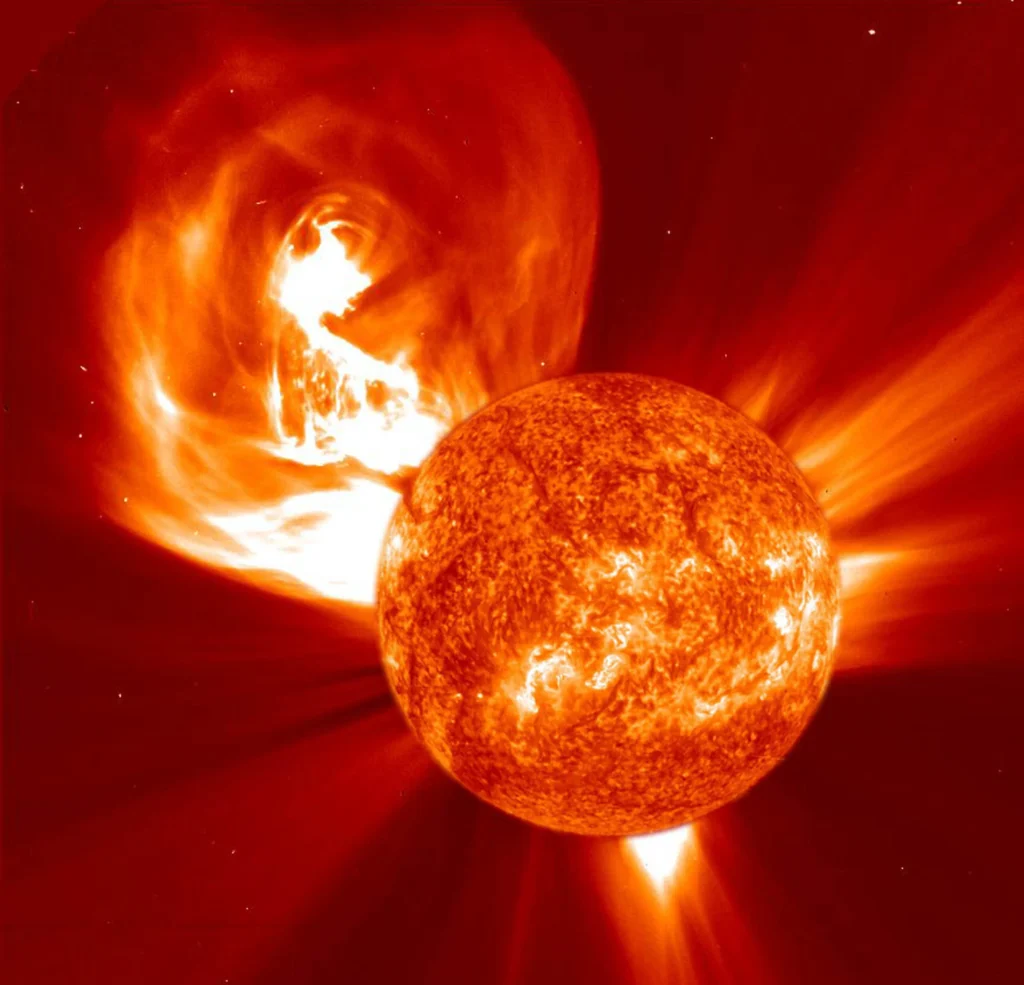Massive Solar Superstorm Nearing Earth May Cause Worldwide Chaos with Internet Disruptions and Power Grid Collapses.
Earth braces for Massive Solar Superstorm; NASA warns of GPS failures, blackouts
Table of Contents
Sun’s Fury Unleashed: A Solar Superstorm Threatens Earth’s Tech Lifeline

The Sun, our life-giving star, has a temper—and it’s flaring up. On May 14, 2025, a colossal sunspot, dubbed AR4087, turned its gaze toward Earth and unleashed an X2.7-class solar flare, the most ferocious of the year. Captured by NASA’s Solar Dynamics Observatory, this explosive event caused temporary radio blackouts across Europe, Asia, and the Middle East, serving as a stark reminder of the Sun’s power to disrupt our hyper-connected world. With the Sun nearing the peak of its 11-year solar cycle, scientists are sounding the alarm: more storms are coming, and we’re not ready. Here’s why this cosmic tantrum matters, what it could mean for life on Earth, and why we need to act now.
A Solar Superstorm is an extreme space weather event caused by a massive release of energy and charged particles from the Sun, typically through powerful solar flares and coronal mass ejections (CMEs). These events disrupt Earth’s magnetic field, triggering intense geomagnetic storms. They are rare but can have severe impacts due to their strength and scale.
Key Features of a Solar Superstorm:
- Origin: Usually sparked by X-class solar flares (the most powerful type) and massive CMEs, which hurl billions of tons of plasma and magnetic fields toward Earth.
- Impact on Earth:
- Power Grids: Can overload transformers, causing widespread, long-lasting blackouts.
- Communications: Disrupts high-frequency radio signals, GPS, and satellite-based systems, potentially causing an “internet apocalypse.”
- Transportation: Affects railways, aviation, and navigation systems reliant on GPS.
- Satellites and Spacecraft: Exposes satellites and astronauts to dangerous radiation, risking damage or failure.
- Auroras: Creates spectacular auroras visible at lower latitudes but signals a major geomagnetic disturbance.
- Speed and Scale: Solar flares travel at the speed of light, hitting Earth in about eight minutes, while CMEs take 1–3 days to arrive. A superstorm’s effects can last days or weeks.
- Historical Example: The 1859 Carrington Event, the most powerful solar storm on record, caused telegraph systems to spark and fail while producing auroras visible in tropical regions.
Why Do Massive Solar Superstorm Nears Earth Happen?
Solar flares are like cosmic fireworks—sudden, violent eruptions of energy, particles, and magnetic fields from the Sun’s surface. They’re born from sunspots, dark patches where magnetic fields twist and snap, releasing bursts that travel at the speed of light. The recent X2.7-class flare, one of the strongest on record, stretched over a million kilometers and hit Earth in just eight minutes. These events are most frequent during the Sun’s solar maximum, a peak in its 11-year cycle when activity surges. Right now, we’re teetering on that edge, and sunspot AR4087 is growing wider and more volatile, hinting at more trouble ahead.
Massive Solar Superstorm : What Could This Mean for Earth?
When a solar flare triggers a geomagnetic storm—a disturbance in Earth’s magnetic field—the consequences can ripple through our tech-dependent lives. The May 14 flare already knocked out high-frequency radio signals for up to ten minutes in some regions. But a true “solar superstorm” could be catastrophic. A recent U.S. emergency drill, led by NOAA and the Space Weather Operations, Research, and Mitigation (SWORM) task force, simulated such an event. The results were chilling:
- Power Grid Failures: A massive storm could fry transformers, causing blackouts lasting weeks. The eastern U.S. seaboard would be hit hardest, plunging millions into darkness.
- Communication Chaos: GPS systems, radio signals, and satellite networks could fail, disrupting everything from aviation to your smartphone’s navigation app.
- Transportation and Energy Disruptions: Railways and gas pipelines could shut down, spiking fuel prices and halting travel.
- Space Risks: Satellites and astronauts face radiation hazards, potentially damaging critical infrastructure in orbit.
While Earth’s atmosphere shields us from harmful radiation, our technology isn’t so lucky. X-class flares, the most dangerous, can wreak havoc on the systems we take for granted, threatening an “internet apocalypse” in extreme cases.
Massive Solar Superstorm : Why We Need to Wake Up and Act
The Sun doesn’t care about our schedules, and its next outburst could catch us off guard. Scientists are urging immediate action to prepare for the worst. The recent U.S. space weather drill—the world’s first—was a wake-up call, showing how unprepared we are for a major solar storm. Here’s what needs to happen:
- More Satellites, Better Monitoring: We need a fleet of space weather satellites to track solar activity in real time. Current systems are stretched thin, and gaps in coverage could mean missed warnings.
- Smarter Forecasting: Upgrading space weather models would give us earlier, more accurate alerts, buying time to protect critical infrastructure.
- Hardened Infrastructure: Power grids, communication networks, and satellites must be reinforced to withstand solar onslaughts. This means investing in resilient tech now, not after a disaster.
NASA’s high-level alert warns of more flares in the coming days, as volatile sunspots continue to churn. The stakes are high, and the clock is ticking.
Massive Solar Superstorm : A Call to Stay Vigilant
The Sun’s beauty—think dazzling auroras—hides its potential for destruction. The X2.7 flare was a warning shot, and with solar activity ramping up, we can’t afford to ignore it. Governments, scientists, and communities must come together to strengthen our defenses against the Sun’s wrath. By investing in better monitoring, forecasting, and infrastructure, we can avoid a technological meltdown. The next solar storm is coming—will we be ready?
